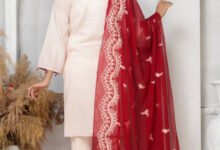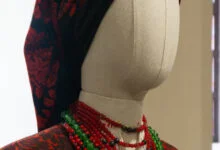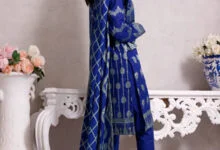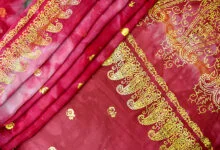The Timeless Elegance of Anarkali Dress with Dupatta

The Timeless Elegance of Anarkali Dress with Dupatta: A Cultural Odyssey
Introduction
The Anarkali dress, paired with a graceful dupatta, is more than just an outfit; it’s a narrative woven into the threads of history, culture, and artistry. This ensemble has transcended time, maintaining its popularity and cultural relevance across generations. Its name, inspired by the legendary courtesan Anarkali, evokes images of timeless beauty and grace. This post explores the rich tapestry of the Anarkali dress with dupatta, from its historical roots to its modern-day allure.
Origin and Evolution
Historical Background
It is claimed that Anarkali wore the dress; this is in line with her fabled beauty and tragic romance. The Mughal empire, a period of grandeur and elegance, was the era from which The Anarkali Dress emerged from.
Evolution Over Time
For ages, the Anarkali dress has undergone a lot of changes so as to meet changing fashion trends but maintaining its classic shape.
The Dupatta’s Role
A dupatta adds modesty, elegance and versatility to the traditional Anarkali dress and is a must-have in South Asian fashion.
Design Elements
Silhouette
What distinguishes the Anarkali dress from others is the fact that it is fitted at the waist and flares dramatically at the bottom, making it a perfect fit for any body shape.
Fabrics
Silk is a luxurious fabric that one might choose due to its light nature and ability to define the formality of an occasion dress.
Embellishments
The allurement of every single piece of this dress is enhanced by the intricate embroidery, beads, and other ornamentations that turn each one into a masterpiece.
Variations
Traditional vs. Contemporary
Although traditional designs are still in vogue, modern versions consist of such elements as asymmetrical hemlines and fusion styles.
Regional Influences
As a result, India’s diversified culture is shown by the distinct regional variations with each region adding their own touch to the Anarkali dress.
Bollywood’s Impact
The Bollywood movie industry has had a strong influence on Anarkali outfits, with clothes from them being seen as highly fashionable.
Styling Tips
The Perfect Fit
It is essential to achieve the desired look by selecting the right length in addition to flaunting a well-fitted Anarkali dress.
Dupatta Draping Styles
The dupatta can be draped in quite a number of styles, and each of them will give the outfit a different feel.
Accessories
The Anarkali dress is always enhanced by the right accessories, whether it be jewellery or footwear.
Occasions and Cultural Significance
Celebratory Wear
Anarkali suits are preferred for weddings and festivals and are adored for their gracefulness and festive charm.
Dance Costumes
At the same time, they are also abundant in Indian classical dancing events, where they help in flowing of the dancer.
Cultural Symbolism
Anarkali’s clothing with dupatta represents a fusion of modesty, tradition and femininity within South Asian society.
Global Influence
Western Adoption
The Anarkali dress has found its way into the Western fashion scene and is liked by many for its unique beauty and adaptability.
Celebrity Endorsements
International celebrities sporting Anarkali dresses on red carpets have further boosted its global appeal.
Fashion Runways
The outfit has appeared on international runways in a bid to represent the global fashion industry’s obsession with South Asian designs.
Market Trends
Domestic and International Demand
The market demand of local and global marketers make the Anarkali dress a trendy outfit.
E-commerce Growth
The availability of Anarkali dresses has been made easier through online platforms, thus broadening their audience and influence.
Pricing Factors
The range in pricing is vast; nevertheless, craftsmanship and quality are often the determinants of costs.
Sustainability and Ethical Practices
Fast Fashion Concerns
When fast fashion rises, there are challenges in the traditional market of Anarkali dress that relate to sustainability and craftsmanship.
Eco-friendly Alternatives
It is becoming increasingly popular to use ecological fabrics and practices in the designing of Anarkali dresses.
Ethical Production
Ethical sourcing and fair labor practices are increasingly important in producing Anarkali dresses.
Future Prospects
Design Innovation
The future of Anarkali suits is in using new ideas to mix tradition with the current fashion trends.
Trend Projections
Emerging trends point towards more personalized and sustainable fashion choices in Anarkali attire.
Challenges and Opportunities
Anarkali dresses are challenged by market saturation and changing fashion trends, but there is a positive side too; the sector can grow and innovate.
Conclusion
A dupatta-adorned Anarkali dress is an example of the way in which traditional clothing styles have been sustained through time, but still changed for the better. The importance of this in relation to fashion and culture reveals why such customs should be maintained as the world keeps changing swiftly. In future, Anarkali dress will symbolize allure, grace, and cultural acceptance; it will charm the generations to come.






